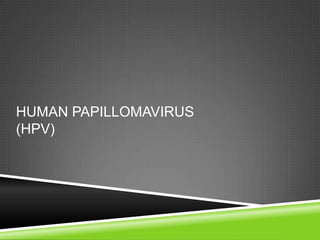Presentation HPV
- 2. What Is HPV ď‚„ HPV stands for the Human papillomavirus. ď‚„ HPV is the most common family of viruses. ď‚„ HPV is the most common sexually transmitted infection. ď‚„ Chances are you will contract some form of the HPV virus in your lifetime and not have any signs or symptoms.
- 3. So why worry about HPV? Other types are considered “high risk” and can cause pre-cancerous lesions and can lead to cancer of the cervix, anus and other genital areas. There are over 100 different types of the HPV virus - most types are totally harmless. Over 30 types of the HPV virus are sexually transmitted and affect the area between the genitals and the anus. Some types are considered “low risk” and can cause warts on the anus, vagina, vulva, penis and thighs.
- 4. Can you prevent HPV? 1. Absolutely no skin-to-skin sexual contact. 2. One sexual / intimate partner forever. 3. The more sexual partners, the higher the chance of contracting HPV. 4. Using condoms is excellent protection against STI, but does not cover all the skin. 5. Pap testing will detect abnormal cells. 6. Vaccination is now available to prevent certain low risk types that cause genital warts certain high risk types that cause cancer. (Gardasil)
- 5. Sources http://www.pkids.org/diseases.html http://www.gwumc.edu/cehp/pdf/HPV_PCPs_Fall- 05_Final.pdf Free and low income STD health clinics in northern Nevada http://yourstdhelp.com/nevada.html




